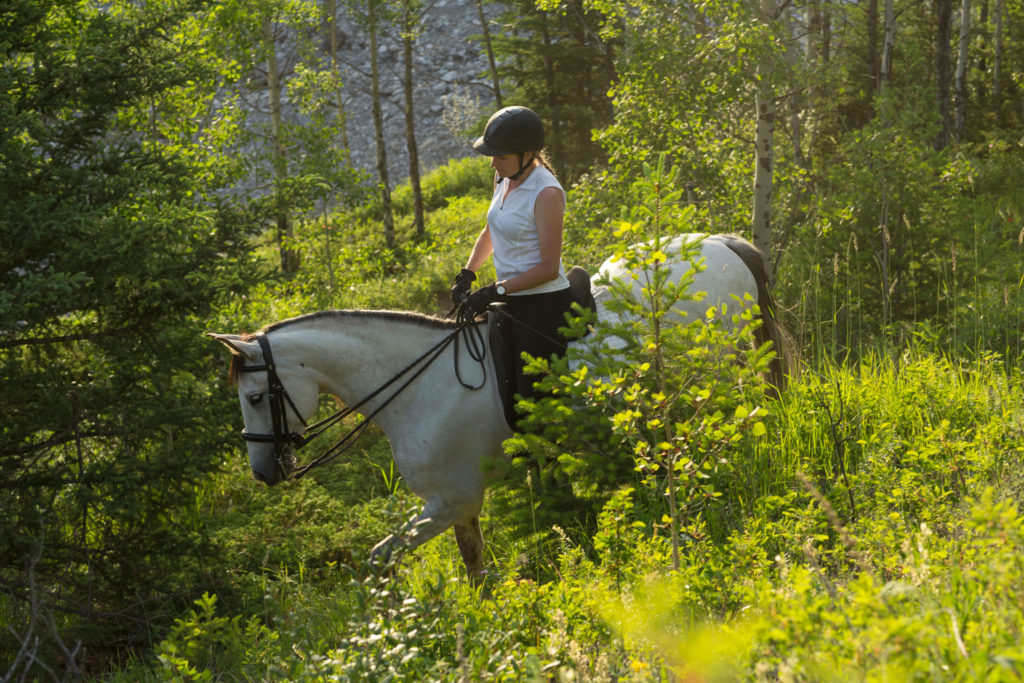
Your horse might encounter a variety of new stimuli including other creatures, such as chickens or cows, novel obstacles on the trail, or spooky objects in the riding arena in his daily life. While some horses are unbothered by these, others find them particularly frightening.
“Horses have different triggers,” says Shawna Karrasch, Pennsylvania-based positive reinforcement trainer. “For some horses, it’s sound. For others, it’s things far away, and for others, it might be things on the ground.”
Regardless of the trigger, Karrasch believes it often ties back to the horse’s sense of smell. Researchers have shown that the horse’s olfactory senses are similar to that of a hound dog, she adds.
“If you’re up close to a horse, you can see them taking big breaths as they gather information through their sense of smell,” she says. “I think that is part of what makes it hard for horses to get used to donkeys. They look kind of like a horse, but they don’t smell (like one).”
Horses tend to be neophobic, meaning new sights, sounds, and smells tend to signal a fear response, which typically prompts them to flee.
Using Positive Reinforcement to Desensitize Your Horse
“It’s not the greatest for our horses’ emotional state for them to be pessimistic and look at everything as dangerous,” Karrasch said. “So, we need to teach them that new things are a potential for good things to happen, to create a positive association—including introductions to different animal species.”
She recommends starting with systemic desensitization and counterconditioning to less-frightening inanimate objects, then slowly building up to sights and sounds that might be more worrisome. For example, notice the distance at which your horse begins appearing uncomfortable with an object, before he crosses over his fear threshold and into fight or flight mode.
Then make a circle with that distance as the closest you allow your horse to get to the object, reinforcing the horse’s experience there using his favorite treat or a click before retreating, says Karrasch. Leaving space allows the horse to self-regulate and realize the experience was positive. Karrasch cautions against treating your horse as you walk away from the object he is fearful of because that reinforces the act of walking away, or possibly learning to scoot from what is scary.
“This allows the horse to form new neuropathways until the circle gets closer and closer, and he doesn’t react,” she says. “By creating the association that new sights, signs, smells are good through a positive reinforcement history, we can create confidence and boldness. So, when it is time to experience something new, they feel less threatened.”
Uses for Systematic Desensitization in Horses
Desensitization through positive reinforcement can even be done in small spaces. Karrasch described a client who suffered multiple injuries due to her horse spooking on the trail. To help reduce her horse’s spookiness on trail rides, Karrasch instructed her to put random items in the barn aisleway. Every time the horse walked by and relaxed, the client clicked or offered a treat to reinforce the positive reaction (relaxation) to the new experience.
The following spring, while the client was trail riding, a partridge flew out of a tree. The horse startled and splayed her feet but did not bolt back to the barn. Startling is an involuntary reflex in horses, but what comes next is key. A second partridge flew up, and the horse looked back at the owner for guidance—the desired response with this form of desensitization training.
“The generalization (the horse’s learned ability to respond in similar ways to similar stimuli) of systematic desensitization in the barn carried over to the trail,” Karrasch said. “This is a context shift that you can practice without flooding them (more on this in a moment) by taking them to a neighbor’s barn or hand walking them by other animals, strengthening the positive behavior.”
Mistakes to Avoid When Desensitizing Your Horse
Karrasch cautions against flooding the animal by exposing him to a frightening object until he stands and “accepts” it. Rather than desensitizing the horse, this process often ends up increasing sensitivity. “The horse realizes all the fight they have is being wasted, so they may go into a state of learned helplessness, and this is the beginning of shutting a horse down,” she said. “It might seem good on the outside, but their head is typically in the same fearful state.”


